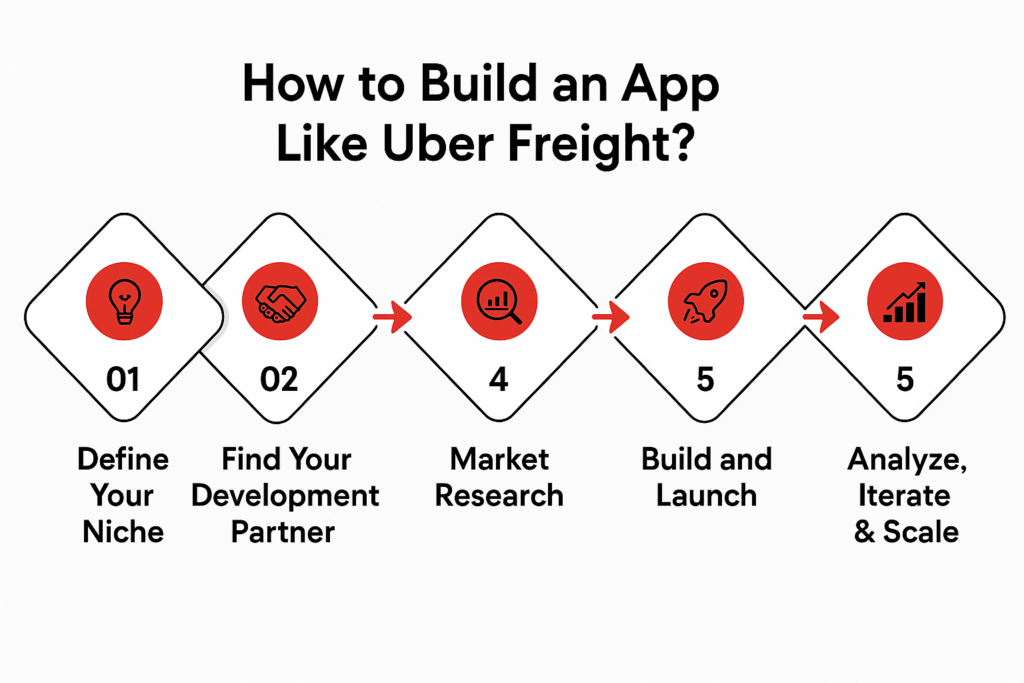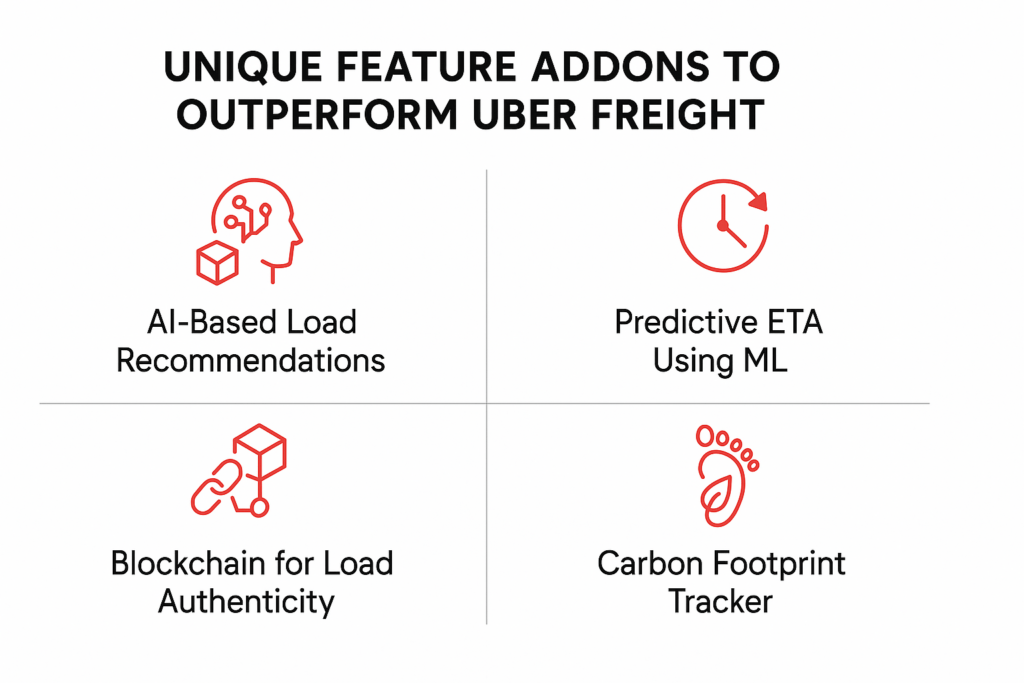HealthTech
Compliance-ready healthcare software development for hospitals, private practices, healthtech startups, and SaaS providers.
Ever waited hours for a truck to arrive, only to find out the shipment was delayed, rerouted, or worse, lost in paperwork? Frustrating, isn’t it? That’s exactly the kind of headache shippers, carriers, and logistics managers deal with every single day.
Now imagine an app that connects shippers with carriers instantly, much like how Uber connects drivers with passengers. That’s the promise of Uber Freight, a platform that has redefined how freight moves by bringing transparency, speed, and automation into an industry notorious for inefficiency.
But here’s the real question: What if you could build your own version of Uber Freight? What would it take? How much would it cost? And more importantly, how can it give your business a competitive edge in 2025’s fast-moving logistics landscape?
The timing couldn’t be better. With the global freight matching market projected to reach past $766 billion by 2034, and over 60% of logistics companies still struggling with manual processes, the opportunity is huge. Businesses that embrace custom freight apps now won’t just keep up—they’ll lead.
In this guide, we’ll break down how to build an app like Uber Freight, essential features you’ll need, the development costs in 2025, and the benefits that make it worth the investment.
Our team specializes in building custom logistics apps designed for scalability, automation, and real-time visibility.
In today’s logistics landscape, digital freight platforms are doing what Uber did for mobility, bringing speed, visibility, and simplicity to an industry long reliant on phone calls and paper-based processes. To build a successful app like Uber freight, businesses must focus on three essential pillars: the Shipper App, the Driver App, and the Admin Dashboard. Together, they form the foundation of a scalable and user-friendly freight ecosystem.
The Shipper App is the central interface for businesses that need to move goods, ensuring they can connect with carriers quickly and transparently.
Key Features:
UI/UX Tips:
The Driver App acts as the control hub for carriers, empowering them to find jobs faster, manage deliveries efficiently, and stay connected on the go.
Key Features:
UI/UX Tips:
The Admin Dashboard is the backbone of the entire platform, giving businesses and operators the tools to monitor, optimize, and scale logistics operations.
Key Features:
UI/UX Tips:
By focusing on these three pillars, and pairing them with thoughtful UI/UX design—entrepreneurs can create a freight app that balances usability, efficiency, and trust, setting the stage to compete with, and even outperform, Uber Freight.
Developing a freight app like Uber Freight requires more than just writing code. It takes strategy, market knowledge, and the right technology partner. Here’s a step-by-step breakdown for businesses and entrepreneurs looking to enter the digital freight space.

Before development, clarify the segment you’ll target—full truckload (FTL), less-than-truckload (LTL), courier, or last-mile delivery.
Why it matters for business: Your choice impacts not only the app’s design and features but also its monetization model and long-term scalability.
Example: A last-mile delivery app needs route optimization and driver tracking, while an FTL-focused platform needs advanced bidding and load-matching features.
You can learn more about that in our detailed guide around the essential features of a freight management system.
Your development partner can make or break your project. Choose a trusted logistics software development company that specializes in freight and supply chain technology.
What to look for in a partner:
This ensures your app isn’t just functional, but reliable, secure, and built for high user load.
Don’t build blindly. Validate your concept before investing heavily:
ROI insight: The earlier you validate, the fewer pivots you’ll need—reducing wasted development costs.
Start lean with a Minimum Viable Product (MVP). Include core features like:
Keep your initial logistics app development cost in check while collecting real-world feedback from early adopters.
After launch, gather data on:
Enhance your app by adding AI-based load recommendations, predictive ETA algorithms, or integrations with TMS/ERP systems. This continuous improvement model ensures your platform scales effectively and outpaces traditional freight management systems.
One of the biggest questions businesses ask is: “How much does it cost to build an app like Uber Freight?” The answer depends on your feature set, technology stack, and development partner, but here’s a clear breakdown to guide you.
Includes core features like:
Best for startups testing the waters with a simple, functional freight app.
Adds advanced features such as:
Suitable for growing businesses that need automation and visibility to compete in the digital freight market.
Includes high-scale, enterprise-level features like:
Designed for logistics enterprises aiming to replace legacy systems with a fully digital freight ecosystem.
Get a tailored cost breakdown for your Uber Freight–style app.
Building a successful freight app isn’t just about connecting shippers and carriers, it’s about solving real logistics challenges. Below are the must-have features for your app in 2025.
Learn more about visibility in our thorough guide about Logistics Dashboards.
Ensure the right load goes to the right carrier at the best price.
Simplify transactions and keep payments flowing seamlessly.
Keep shippers, drivers, and dispatchers connected in real time.
Go paperless while keeping compliance in check.
Turn freight data into actionable business insights.
If you want to outpace competitors like Uber Freight and Convoy, consider adding:

Choosing the right technology stack for logistics apps is one of the most critical steps in creating a scalable, high-performance freight platform like Uber Freight. The right tools ensure faster development, seamless integrations, and long-term adaptability as your business grows. Here is a breakdown of the key technologies most commonly used in freight app development:
| Framework | Key Strengths | Best Use Case in Freight Apps |
|---|---|---|
| React Native | Cross-platform with native-like performance, reusable components, strong ecosystem. | Ideal when you want faster time-to-market and reusable code for both iOS & Android. |
| Flutter | Rich pre-designed widgets, smooth UI, near-native speed, backed by Google. | Best for building visually rich, highly interactive freight apps with consistent UI across devices. |
Backend: Node.js vs Python (Django) vs Express.js
| Backend Option | Key Strengths | Best Use Case in Freight Apps |
|---|---|---|
| Node.js | Handles asynchronous events efficiently, lightweight, scalable. | Great for real-time tracking, notifications, and instant updates. |
| Python (Django) | Robust, secure, enterprise-grade, perfect for large data sets. | Best for complex freight platforms needing heavy data processing and compliance. |
| Express.js | Minimalistic Node.js framework, easy to build APIs fast. | Ideal for quick MVP development or lightweight API layers. |
| Database | Key Strengths | Best Use Case in Freight Apps |
|---|---|---|
| PostgreSQL | ACID-compliant, highly reliable, strong for transactions. | Best for transaction-heavy freight operations (payments, contracts). |
| MongoDB | NoSQL, scalable, flexible for unstructured data. | Best for document storage (ePOD, invoices, Bills of Lading). |
| Service | Purpose | Why It Matters for Freight Apps |
|---|---|---|
| Twilio | Real-time messaging & notifications. | Keeps shippers & drivers updated instantly. |
| Google Maps API | GPS tracking, optimized routing. | Enables accurate location services & ETAs. |
| Stripe | Secure payment gateway. | Ensures safe transactions between shippers & carriers. |
| AWS S3 | Cloud document storage. | Stores ePOD, invoices, BOLs securely. |
| SendGrid | Transactional emails. | Delivers status updates & confirmations reliably. |
| Cloud Provider | Key Strengths | Best Use Case in Freight Apps |
|---|---|---|
| AWS | Industry leader, wide service range, reliable. | Best for large-scale freight apps needing high uptime & global reach. |
| GCP | Advanced AI/ML tools, Kubernetes support. | Ideal for real-time analytics & predictive logistics. |
| Azure | Enterprise-grade, seamless with Microsoft tools. | Best for enterprise logistics companies using Microsoft ecosystem. |
Your freight app technology stack directly impacts scalability, speed, and cost-efficiency. Choosing the right combination of tools ensures your platform can adapt to industry changes, integrate AI-driven features, and deliver the reliability that shippers and carriers expect from Uber Freight–style solutions.
Investing in a custom freight app isn’t just about going digital—it’s about unlocking scalability, efficiency, and profitability. Here’s how businesses benefit from Uber Freight–style solutions in 2025.
Automation lowers expenses and eliminates inefficiencies.
Real-time insights build trust and speed up decision-making.
Integrated payments remove financial bottlenecks.
Better collaboration strengthens long-term partnerships.
Future-ready platforms grow with your business.
Let’s help you design a scalable, Uber Freight–style solution built for growth.
The freight industry is rapidly shifting toward digitization and automation. With platforms like Uber Freight proving the value of on-demand logistics, businesses that adopt similar models are seeing:
Whether you’re a startup exploring MVP development or an enterprise looking to replace outdated systems, investing in a custom logistics app development company can future-proof your business and give you a lasting competitive advantage.
Let’s turn your idea into a high-performing freight platform.
Yes, Uber Freight is growing and generated over $7 billion in revenue in 2023. Profitability factors include:
Discover how our team can help you transform your ideas into powerful Tech experiences.